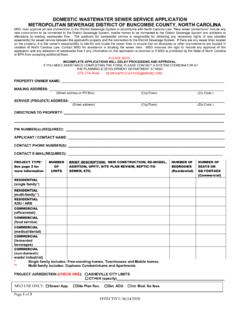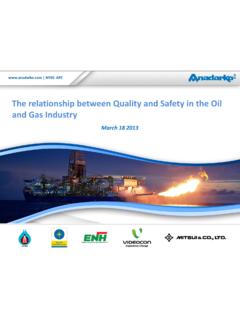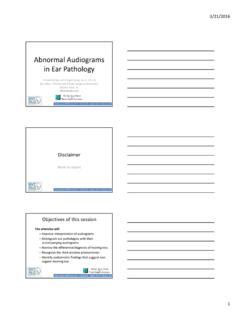Transcription of SEWER CONDITION CLASSIFICATION MANUAL - …
1 1 Construction Codes CONSTRUCTION CODES Use construction codes to identify features associated with the installation of the SEWER . The codes provided here will be used to identify encountered, pre-existing construction features such as connections, manholes, etc., as well as defective connections, linings, and so forth. Connection Factory Use this code when a service lateral pipe intersects the SEWER main with a factory fitting. Enter the clock hour reference to locate the service lateral. Enter the lateral diameter, in inches, and also, enter Plugged if applicable in the comments section. CNF = Connection Factory at .. o clock, diameter .. in Plugged (if applicable). The connection factory code refers to a factory installed opening for connection to a service lateral. CNF 2 Construction Codes Connection (Plumber s) Use this code when a plumber s connection does not protrude enough to obstruct flow or camera travel in the main.
2 The field cut or break-in in the main for the lateral must also not be excessively oversized. If soil is visible where the lateral enters the main, a Connection Defective code should be used instead. Enter the clock hour reference to locate the service lateral. Enter the lateral diameter, in inches. CNO = Connection (Plumber s) at .. o clock; diameter .. in CNO 3 Construction Codes Connection (Plumber s) Protruding Use this code when a plumber s connection protrudes into the SEWER line. Enter the clock hour reference. Enter the length of the protrusion. CNP = Connection protruding at .. o clock, in, protrusion .. in (Still Image Required only if camera will not pass or if protrusion is obstructing normal pipe flow) CNP 4 Construction Codes Defective Connection The connection has become damaged during or after construction or reduces the flow capacity because of intrusion into the SEWER line.
3 The specific defect, the connection type (factory or plumber s tap), the service lateral material (clay, PVC, etc.), and Plugged if applicable, must be noted in the comments section. CNX = Connection defective at .. o clock, diameter .. in, specific defect, connection type, lateral material, Plugged (if applicable) (Still Image Required) The defective connection code indicates a connection that is no longer properly connected to the SEWER line..CNX 5 Construction Codes Lining Defect Use the lining defect code to indicate that there is a defect in the lining of the SEWER . It may appear as a bulge, missing section, or separation from the SEWER wall. Enter the clock hour reference. Enter details of the defect in the comments section. LN = Lining defect from .. to .. o clock, details of defect (Still Image Required) LN 6 Construction Codes Manhole Enter the full manhole reference number in the comments section.
4 MH = Manhole, Manhole number Manhole Unmapped MHU = Manhole unmapped, new manhole number If a manhole is discovered during the TV inspection which is not shown on the District s mapping, a District representative shall be notified to assign a new MH number to the found manhole. 7 Miscellaneous Codes MISCELLANEOUS CODES Use these codes to define items that are not defects or features. Camera Under Water Use this code to note that the CCTV camera has become submerged. Enter the code and distance readings when the camera becomes submerged and when it is no longer under water. CU = Camera under water 8 Miscellaneous Codes Dimension Change Use this code when the diameter of a circular pipe or the dimensions of a non-circular pipe changes. The new diameter/dimensions, in inches, should be entered. DC = Dimension of SEWER changes, new dimension .. in (Still Image Required) DC 9 Miscellaneous Codes General Observation Use this code to document an observation only when another more specific code is not applicable.
5 Enter a description of the observation in the comments section. GO = General Observation, description 10 Miscellaneous Codes Material Change Used in instances where the material of the SEWER line has changed. Details of the change ( , new material type) should be provided in the comments section. MC = Material of SEWER changes at this point, new material type MC 11 Miscellaneous Codes Survey Abandoned Use this code to note that the survey could not be continued due to a blockage in the line, collapse of the line, or an excessively high water level. Use this code only after using a specific defect code such as collapsed pipe . Use this code at the same distance from the start manhole as the specific defect code. The reason for abandoning the survey shall be entered in the comments section, if not fully documented by the specific defect code. SA = Survey Abandoned, reason inspection abandoned. Water Level Enter this code at the beginning of the survey length as well as at any points at which the water level noticeably changes.
6 WL = Water Level from .. o clock to .. o clock 12 Service Codes SERVICE CODES Use service codes to address the pipe s ability to meet its service requirements. These codes indicate any loss of flow capacity (not related to structural defects), infiltration, or obstructions in the line. When using these codes, make a note in the comments section if the defect occurs only at a joint. If the defect occurs more than 1 foot from the joint or if the defect continues from joint to joint along the length of the pipe the joint comment should not be entered. Debris Use the debris codes when pipe materials or other objects that can cause more turbulent flow and/or a reduction in flow capacity are in the line. The material may be either organic or inorganic. Debris is classified into three categories: Silt (silty material, normally found in the pipe invert); Grease (grease deposits normally found above the flow line); Non-silt/grease (materials often found as a result of construction).
7 DE = Debris (non-silt/grease) from .. o clock to .. o clock DEG = Debris grease from .. o clock to .. o clock DES = Debris silt from .. o clock to .. o clock DE 13 Service Codes DEG DES 14 Service Codes Encrustation and Scale Use the encrustation and scale code to indicate a mineral deposit or build-up on the pipe walls. Enter occurs at joint only in the comments section if deposits occur only at the joint. Enter EL or EH begins or EL or EH ends in the comments section. EL = Encrustation and Scale light from .. o clock to .. o clock EH = Encrustation and Scale heavy from .. o clock to .. o clock EL EH 15 Service Codes Infiltration Use the infiltration codes when ground water from outside the pipe is leaking into the pipe through defects in the line or connections. Three codes are used to describe this defect; each code depends on the amount of water leaking in.
8 Seeper - Water flowing slowly through a defect or faulty joint, or signs or stains of past infiltration Dripper - Water dripping in through defects in the line or joints Gusher - Water gushing in through a defect or faulty joint. IS = Infiltration seeper from .. o clock ID = Infiltration dripper from .. o clock (Still Image Required) IG = Infiltration gusher from .. o clock (Still Image Required) IS 16 Service Codes ID IG 17 Service Codes Line Deviation Use the line deviation codes when a constructed visible deviation in the direction of the SEWER line occurs. If the line deviates due to a factory bend but the survey is continued through the bend, note the degree of bend in the comments section. If the survey cannot be continued through the bend, use the Survey Abandoned code and note the degree of bend in the comments section. LD = SEWER line deviates down (Still Image Required) LL = SEWER line deviates left (Still Image Required) LR = SEWER line deviates right (Still Image Required) LU = SEWER line deviates up (Still Image Required) LD 18 Service Codes Line Sags Use the line sags codes when there is a visible localized sag.
9 Care must be taken not to confuse the sag code with a line deviating down by construction. Line sags are many times identified by a localized increase in water level. DS = DIP/SAG Start DF = DIP/SAG Finish 19 Service Codes Obstruction Use the obstruction code when large objects are found in the line. Typically, obstructions will be objects that will considerably reduce the flow capacity of the SEWER and may also force the survey to be abandoned. The obstruction code also requires a percent of cross-sectional area lost entry. Enter the type of obstruction in the comments section. OB = , .% cross sectional area lost; type of obstruction (Still Image Required). OB 20 Service Codes Obstruction Utility Use the obstructing utility code when other utilities are found in the line. Typically, utilities will considerably reduce the flow capacity of the SEWER and may also force the survey to be abandoned. The obstruction utility code also requires a percent of cross-sectional area lost entry.
10 If the obstruction is a recognized utility, enter the utility type in the comments section. If the utility type is not recognized, enter utility type unknown in the comments section. OBU = Obstruction , % cross sectional area lost; type of utility (Still Image Required). OBU 21 Service Codes Roots Use the roots codes when roots have intruded through defects in the line, joints, connections, or manholes. The root code has two degrees of severity (fine or heavy) depending on the amount of root intrusion. The roots heavy code also requires a percentage of cross-sectional area lost entry. Fine roots are defined as stringy, thin roots intruding into the pipe material or at the joint. Heavy roots can best be described as large singular roots that are capable of creating an obstruction in the SEWER line or a root mass that reduces the pipes carrying capacity. RF = Roots fine from .. o clock to .. o clock RH = Roots heavy from.







